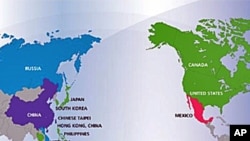In January of 1989, Australian Prime Minister Bob Hawke first publicly suggested the idea of an Asia-Pacific grouping to discuss trade and other issues. Later that year, 12 Asia-Pacific nations meet in Canberra, Australia to establish APEC.
The organization focuses on three areas, known as the Three Pillars.
- Trade and Investment Liberalization
- Business Facilitation Economic
- Technical Cooperation
|
APEC by the Numbers
|
1991: China, Hong Kong and Taipei join APEC.
1993: President Bill Clinton begins practice of annual APEC leaders economic summit.
Mexico and Papua New Guinea join.
1994: At meeting in Bogor, Indonesia, APEC sets the goal of “free and open trade and investment” for developed nations in the Asia-Pacific region by 2010, and 2020 for developing nations.
Chile joins.
1998: Peru, Russia and Vietnam join.
2001: APEC issues its first counter-terrorism statement, which broadens its focus beyond economics and trade.
2003: In addition to pledging its support for the Doha round of world trade talks, APEC leaders pledge to work to dismantle terrorist groups and form an action plan on fighting the disease SARS and other health issues.
2005: APEC leaders assess progress on Bogor goals and determine the group is halfway to meeting its targets.
2007: For the first time, APEC leaders issue a declaration on climate change, energy security and clean development, which includes a program to address those issues.
2010: APEC leaders pledged to work toward realizing a Free Trade Area of the Asia Pacific, known as FTAAP. And they endorsed the APEC Growth Strategy, aimed at producing balanced, inclusive, sustainable, innovative and secure growth.









